Stellafane Names in Space
Astronomical Objects Named after Stellafane or Club Members
There are seven asteroids, four craters and many comets named after Stellafane or club members by the International Astronomical Union, to honor our contributions to astronomy. The IAU is the only organization that can officially name astronomical bodies or features. Below you will find information on each of them.
Objects named for Stellafane or Porter
Lunar Craters Porter, Porter B, Porter C
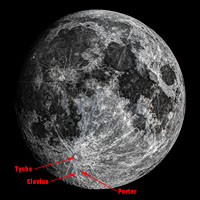
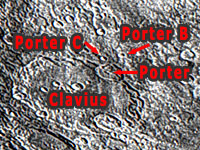
In 1970, the year following the first human landing on the moon, the crater formerly designated as Clavius B was renamed Porter in honor of our club's founder Russell W. Porter for his many accomplishments in amateur and professional astronomy. Clavius is the second largest visible crater on the moon, in the southwest, and Porter is a smaller (54 km diameter) crater that disrupted the northeast wall of Clavius.
In 2006, two smaller craters of 11km diameter that lie to the northeast of Porter, and are therefore outside of Clavius, were named Porter B and Porter C.
All three can be seen in amateur telescopes, and should be easy to locate given their positions relative to the easy-to-find large craters Tycho and Clavius as shown on the image at right.
The High Dynamic Range lunar images in the section were taken by STM member Tom Spirock using a 6-inch f/15 refractor at Mount Wilson Observatory on July 25, 2018., We have annotated them with the crater's locations to help you find them - take a look at them if you haven't already.
Martian Crater Porter
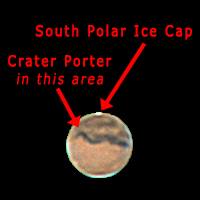
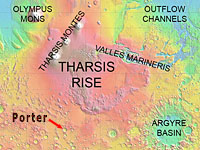
In 1973, the International Astronomical Union named a large, 194 km diameter crater on the surface of Mars for Russell W. Porter. At 50° south, it's mid-latitude in the southern highlands, a little southwest of the rocky Tharsis Rise. Tharsis Montes, a group of three large shield volcanoes are due north of it.
Unfortunately, this crater is not resolvable in earthbound amateur telescopes.
The full planet image of Mars was taken by STM member Tom Spirock and three other club members on 2020-10-16, using a 4" refractor operating at f/23 from Dunbarton, New Hampshire. The camera used was a ZWO ASI1600MM-S; Video legths in seconds: R=60, G=30, B=30. South is up, and the planet's central meridian is at 182°.
| Crater Name | Diameter in km | Center Latitude | Center Longitude | IAU Named |
Locator Map |
|---|---|---|---|---|---|
| Porter | 193.99 | -50.36 | 246.24 | 1973 | Click |
Asteroid 3140 Stellafane
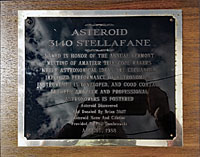
In 1988, Asteroid 3140 was named Stellafane in honor of our annual convention, and the contributions it has made to both amateur and professional astronomy both for ideas and inter-personal networking between amateurs and professionals (Click on the plaque at right to read the exact text of the dedication). Asteroid 3140 was discovered on January 9, 1983 by Brian Skiff while observing at Anderson Mesa Station which is operated by Lowell Observatory. The name and citation was proposed by Phil Dombrowski.
Stellafane is a main belt asteroid that takes 5.24 years to make one orbit around the Sun at a maximum distance from the Sun of 3.015 au and minimum distance of 2.681 au. It's diameter is 20.213 km and rotates once every 19.23 hours. It's absolute magnitude is 10.9.
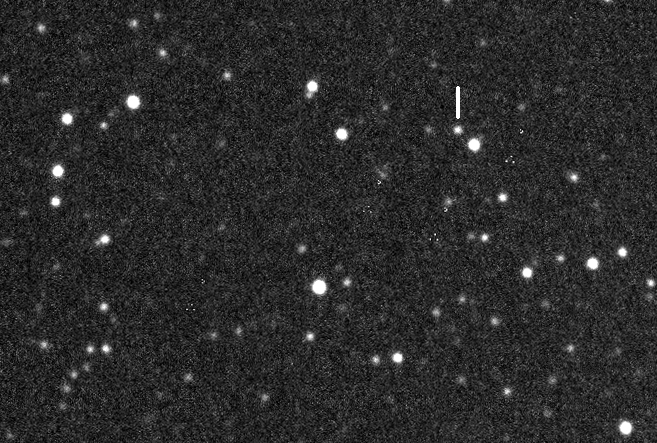
Additional data, including orbital elements, are available from the JPL Small-Body Database Browser.
Asteroid 329069 Russellporter
Dr. Larry Wasserman of Lowell Observatory has informed us that the minor planet 329069, discovered by him at Kitt Peak National Observatory on October 20, 2006, has been officially named 329069 Russellporter. The announcement was published on 2022-Aug-03 by the International Astronomical Union's Working Group for Small Bodies Nomenclature in WGSBN Bulletin, volume 2, number 10, July 25, 2022.
Main belt asteroid, absolute magnitude 17.12, orbits in 4.13 years.
Additional data, including orbital elements, are available from the JPL Small-Body Database Browser.
— Objects named for Other Club Members —
Asteroid 3031 Houston
In 1986, Asteroid 3031 was named in honor of Walter Scott Houston, American amateur astronomer well known for his column "Deep Sky Wonders" in the magazine "Sky and Telescope". Houston has specialized in the visual study of deep-sky objects and has guided countless amateurs to view and marvel at the varied objects within the grasp of small telescopes. Scotty was the original shadowgram speaker at the Stellafane convention.
Discovered 1984-Feb-08 by E. Bowell at the Anderson Mesa Station of the Lowell Observatory. Name proposed by the discoverer following a suggestion by P. L. Dombrowski.
Main belt asteroid, absolute magnitude of 12.8, diameter of 6.430 km, orbits in 3.34 years.
Additional data, including orbital elements, are available from the JPL Small-Body Database Browser.
Asteroid 3841 Dicicco
In 1990, Asteroid 3814 was named in honor of Dennis di Cicco, since 1974 a staff member and since 1983 an associate editor of Sky and Telescope. An imaginative and outstanding astrophotographer, he has participated in many expeditions, specifically to observe eclipses and comets, although his best-known work is probably the analemma showing the Sun from the same spot at the same mean time every few days throughout the year. Particularly meticulous and appropriately cautions in all his writings, he regularly conducts the ‘Observers Page’ column in the magazine.
Main belt asteroid, absolute magnitude of 13.1, diameter of 6.252 km, orbits in 3.43 years. Interestingly, this asteroid is a binary with two pieces closely orbiting each other in about 3.6 hours.
Additional data, including orbital elements, are available from the JPL Small-Body Database Browser.
Asteroid 10715 Nagler
In 1999, Asteroid 10715 Nagler was named in honor of Al Nagler (b. 1935) is an optical designer best known for his innovative wide-field eyepieces and versatile, compact refractors. He also designed visual displays for the Gemini and Apollo Lunar Module simulators.
Discovered 1983-Sep-11 by B. A. Skiff at the Anderson Mesa Station of the Lowell Observatory. The citation was provided by Sue and Alan French.
Main belt asteroid, absolute magnitude of 13.6, diameter of 5.231 km, orbits in 4.27 years.
Additional data, including orbital elements, are available from the JPL Small-Body Database Browser.
Asteroid 13822 Stevedodson
In 2003, Asteroid 13822 was named for Steve Dodson (b.1943-12-26) who did graduate work in nuclear physics at the University of Ottawa in the 1960s, then taught high school in northern Ontario. From 1982 to 1992, he was on the staff at Science North, in Sudbury. Beginning in 1994, he made thousands of small "Stargazer Steve" telescopes.
Discovered 1999 Nov. 2 by Spacewatch at Kitt Peak. Name proposed and citation prepared by Peter Jedicke and Robert Jedicke.
Main belt asteroid, absolute magnitude of 15.1, no available diameter, orbits in 3.52 years.
Additional data, including orbital elements, are available from the JPL Small-Body Database Browser.
Asteroid 18024 Dobson
In 2001, asteroid 18024 was named for John Dobson (b. 1915), who is one of the most important popularizers of astronomy of the twentieth century. His telescope design has spread around the world and enabled amateur astronomers to use larger apertures than before. He demonstrates a passion for sharing his knowledge of the universe with the public at large.
Discovered 1999-May-20 by J. M. Roe at Oaxaca.
Main belt asteroid, absolute magnitude of 13.9, diameter of 5.243 km, orbits in 5.68 years.
Additional data, including orbital elements, are available from the JPL Small-Body Database Browser.
Asteroid 47650 Tuthill
In 2023, asteroid 47650 was named for Roger Tuthill (1919-2000), who was a long-time member of Amateur Astronomer's, Inc., Stellafane, the United Astronomy Clubs of New Jersey (USA), and many other astronomy organizations. He was well known for eclipse chasing, having observed at least 18 total solar eclipses and was well known for his innovative astronomical products and thin-film solar filters.
Discovered 2000-02-01 by CSS at Catalina.
Main belt asteroid, absolute magnitude of 13.50, diameter of 5.465 km, orbits in 4.83 years,
Additional data, including orbital elements, are available from the JPL Small-Body Database Browser.
Multiple Periodic Comets Levy
David Levy has discovered at least 22 comets, either independently or with Gene and Carolyn S. Shoemaker, all of which include his name in their official designation. He is best know for co-discovering Comet Shoemaker–Levy 9 in 1993, which collided with the planet Jupiter in 1994. For many years, David Levy was the shadowgram speaker at the Stellafane convention.
Back to the Modern History Page

